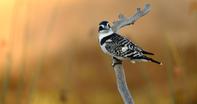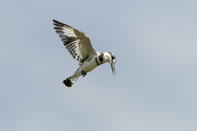
Name
Pied kingfisher (Ceryle rudis)
Appearance

Pied Kingfisher Diet
The pied kingfisher feeds primarily on fish, but will take large aquatic insects and small crustaceans.Pied Kingfisher Breeding
The pied kingfisher is gregarious and uses co-operative breeders, with the helpers usually being male offspring. The helpers assist with feeding the breeding birds and the chicks. They nest in self-excavated tunnels in sandbanks or riverbanks. Between 2 and 6 eggs are laid.Pied Kingfisher Behaviour
The pied kingfisher is often seen hovering over water before diving bill first into the water to catch its prey. The pied kingfisher is the only kingfisher that hovers. It can swallow small prey in flight and does not have to return to a perch like other fish feeding kingfishers. When not breeding pied kingfishers have been known to form large roosts overnight.Adaptations

The pied kingfisher is adept at hovering in order to look for food in the water. This is achieved by using a figure of eight wing stroke (effectively reversing the wing beat on the up-stroke to stay in the same place). This is a very costly form of flight and can not be sustained for very long. True hovering involves the ability to move forwards and backwards (like the hummingbird) which the kingfisher cannot do but rather the kind of hovering it practices is termed aerial perching.
The pied kingfisher has eyes adapted to correcting for refraction so as to be able to determine the exact position of fish under the water and also to make adjustments for last minute deflections by the fish. When it dives, the pied kingfisher will also close its nictitating membrane (transparent eyelid) to help with underwater vision.
Distribution and Habitat
Pied kingfishers are found throughout sub-Saharan Africa, near water.By Megan Emmet